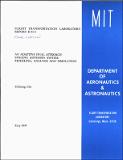| dc.contributor.author | Chi, Zhihang | en_US |
| dc.contributor.other | Massachusetts Institute of Technology. Flight Transportation Laboratory | en_US |
| dc.date.accessioned | 2012-01-06T22:26:07Z | |
| dc.date.available | 2012-01-06T22:26:07Z | |
| dc.date.issued | 1991 | en_US |
| dc.identifier | 24101873 | en_US |
| dc.identifier.uri | http://hdl.handle.net/1721.1/68116 | |
| dc.description | May 1991 | en_US |
| dc.description | Also issued as an M.S. thesis, Massachusetts Institute of Technology, Sloan School of Management, 1991 | en_US |
| dc.description | Includes bibliographical references (p. 75) | en_US |
| dc.description.abstract | As airline industry grows and air traffic increases drastically, terminal airspace around busy airports is becoming more and more crowded. To accommodate the soaring demand for use of airports, a plausible and profitable way is to improve the efficiency of existing airports. An automated final approach spacing system can improve the efficiency as well as alleviate the workload of air traffic controllers. In this thesis we develop an automated adaptive and interactive Final Approach Spacing Advisory (FASA) system to be used in future at busy airports. Our system is able to generate and update final approach paths for aircraft and guarantee that the aircraft land as scheduled and safely spaced. It prompts air traffic controllers for calls of turns. It can also detect errors in the execution of final approach paths and provide warning and correcting cues for the controllers. We will elaborate on the motivation for this thesis in Chapter 1. In Chapter 2, we will define the problem of Final Approach Spacing and describe the operations involved. We will introduce the key idea of our model - schedule box and sketch the framework of our system. In Chapter 3, we will establish a mathematical model for our proposed system, analyze it and obtain the solution to it. We will show that our model is capable of incorporating any constraints and that the whole problem can be reduced to finding feasible solutions to a linear system of two variables. In Chapter 4, we will develop a simulation program to implement our model in Chapter 3. We will describe in detail the algorithms and logics of our simulation program. Finally in Chapter 5, we give a summary of our achievements as well as the topics and directions of future research. | en_US |
| dc.format.extent | 75 p | en_US |
| dc.publisher | Cambridge, Mass. : Flight Transportation Laboratory, Dept. of Aeronautics and Astronautics, Massachusetts Institute of Technology, [1991] | en_US |
| dc.relation.ispartofseries | FTL report (Massachusetts Institute of Technology. Flight Transportation Laboratory) ; R91-3 | en_US |
| dc.subject | Airports | en_US |
| dc.subject | Air traffic control | en_US |
| dc.subject | Airplanes | en_US |
| dc.subject | Traffic control | en_US |
| dc.subject | Mathematical models | en_US |
| dc.subject | Landing | en_US |
| dc.title | An adaptive Final Approach Spacing Advisory system : modeling, analysis and simulation | en_US |
| dc.title.alternative | Adaptive FASA system : modeling, analysis and simulation | en_US |
| dc.type | Technical Report | en_US |
